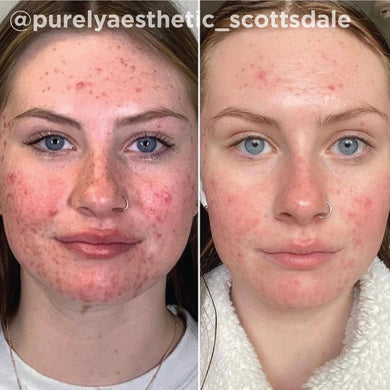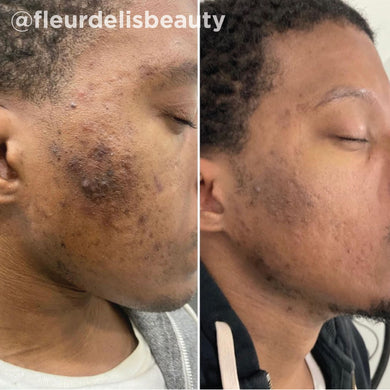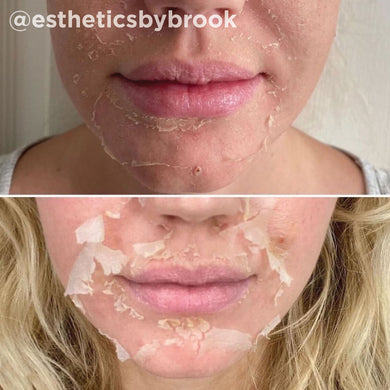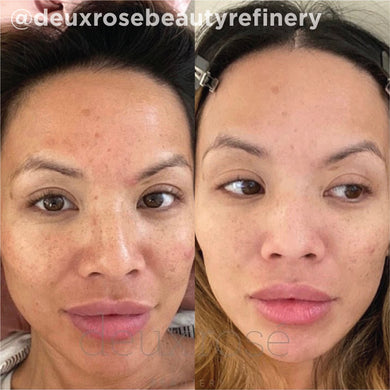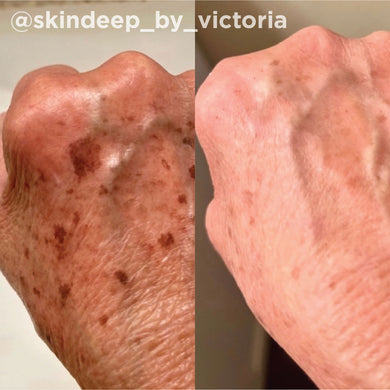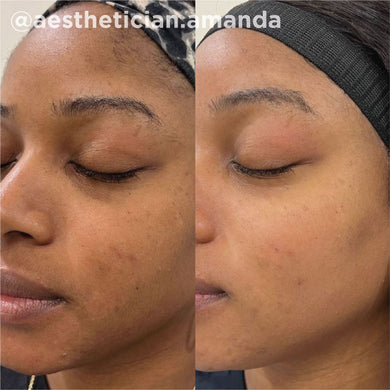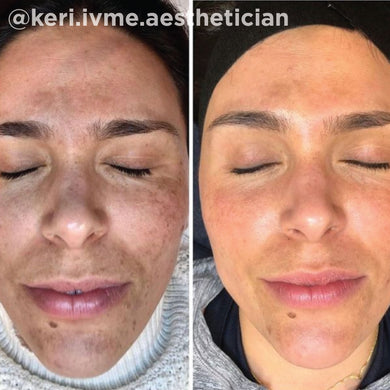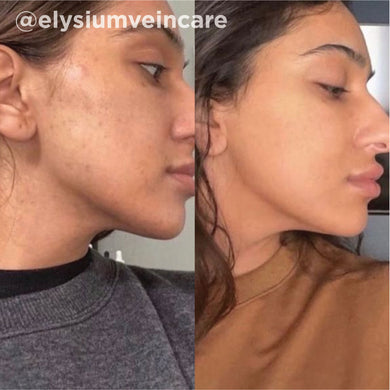3 reasons why hair loss is different for darker skin tones—and what you can do about it, say these experts
Written by Alia Brown, MD, FAAD & Chesahna Kindred, MD, FAAD as part of The Brown Skin Agenda Initiative
As a clinical skincare brand that promotes skin health as a whole, we believe that proper skincare maintenance extends beyond the face – and this goes for the skin on your head!
Beyond thinking about what causes hair loss (think internal factors like the natural aging process and external factors like smoking and hair dyes, to name a few), studies show that hair growth and hair loss differ across ethnicities and skin of color and must be treated with a unique understanding of genetics and cultural influences.
That’s why The Brown Skin Agenda enlisted the expertise of two dermatologists, Dr. Chesahna Kindred, owner of Kindred Hair & Skin Center, and Dr. Alia Brown, co-owner of Georgia Dermatology Partners, who have passionately helped treat and manage hair loss in skin of color, as well as educate on how to stimulate hair growth to make their clients feel more confident. Here, they take a deep-dive into the root of hair loss—as well as treating hair loss, so you can feel more confident and amazing in your own skin.
Simply put, hair growth needs to be an extension of how we approach skin health
The skin on your scalp is different than the rest of your skin (we’ll get to that later), and the health of your scalp can be indicative of how hair grows…or doesn’t grow. But that’s not all.
When compared to your facial skin, skin on your scalp:
- Is thicker, yet more delicate because it relies on your hair for environmental defense
- Has more blood vessels
- Has more sebaceous glands
What causes hair loss and hair thinning, regardless of ethnicity?
Hair, like skin, is comprised of proteins, and its color is dictated by melanin. Many nutrients and vitamins are needed to create the proteins that give us a head of hair, and those nutrients decline as we age. Brown says, “Combine the natural aging process with UV damage, lifestyle choices like smoking, and hair styling practices, and hair follicles ultimately ‘age’ by becoming more fine and less dense.” Additionally, patients may have a genetic predisposition to hair loss, or have nutritional or hormonal imbalances.
Why is hair loss different for darker skin tones?
- Hair on Black and Brown skin have fewer cuticles, therefore the hair is less dense
Hair cuticles are on the outermost layer of your hair. Similar to the outermost layer of your skin, they absorb and manage the majority of external, day-to-day damage. “Cuticles are important because they insulate the cortex of your hair from damage,” Kindred says. When compared to Caucasian or Asian hair, Black hair has fewer cuticles and is not as well insulated against internal factors and external damage. “This can be a legitimate factor contributing to hair loss in skin of color,” Kindred says.
- Hair on darker skin breaks more rapidly than it grows
In addition to fewer cuticles, Black and Brown hair is more prone to breakage. “Hair that is more coarse tends to be fragile, vulnerable to heat and chemical exposure and require nourishing conditioning products that make styling easier to prevent breakage and damage,” Brown says.
- Hair on darker skin typically undergo more styling and processing
Again, this speaks to the extrinsic triggers of hair loss. Trending styling techniques like braids and hair protective styles can cause tension, pulling, and excessive weight on the scalp due to length of the hair, which can cause traction hair loss. Other treatments like chemical relaxers, texturizers, keratin treatments, and heat can create inflammation at the follicle which can cause permanent scarring and can also cause the hair to fall out and have difficulty regrowing once the follicle is damaged.
Let’s dig deeper on this. Kindred says, “Recent studies by dermatologists and geneticists discovered a gene that’s linked to Central Centrifugal Cicatricial Alopecia (CCCA), a progressive, inflammatory disease that destroys the hair follicles and causes permanent hair loss—making it virtually impossible to regrow hair once the disease has set in.” While more studies are needed to determine the exact cause of CCCA, there is research that shows it has multiple triggers, “one of which is the inflammation caused by excessive styling involving heat, chemical relaxers and texturizers,” Kindred says.
“Many patients are able to perceive the scalp inflammation, however some do not,” says Kindred. The inflammation can feel like a stinging/burning sensation, tenderness, and soreness. The inflammation may present as painful tiny bumps, scaling and flaking, shedding, and eventual scarring.
Signs of hair loss that go beyond shedding and can include:
- A widening of the part line
- Clumps of hair lost during hair washing or brushing (this should be significantly more noticeable than shedding, as shedding is normal)
- Noticeable hair loss on the eyebrows, eyelashes, or in the beard or anywhere else hair grows, as well as textural changes on the facial skin near the hairline and temples
- Redness around hair follicles, acne-like bumps, sores or blisters
- Bald patches
- Itching or burning sensation and scalp tenderness followed by hair loss
What can you start doing right now to stop hair loss?
• Take a break from hair treatments to minimize the breakage
Kindred says, “If you or your stylist notices any of the signs of hair loss or hair trauma listed above, don’t do any at-home treatments. Take it easy on excessive heat, relaxers, texturizers, hair dyes, and minimize tension to your follicles as hair regrows. Consider scheduling a consultation with a dermatologist that specializes in hair loss.” Minimizing tension on your hair include avoiding tight ponytails and hairstyles that tug on the hairline, as this can lead to Traction alopecia, or hair loss caused by pulling/tugging on your hair. And lastly, even if you aren’t noticing any hair loss signs listed above, it’s always best to give your hair a break now and then.
A dermatologist like Kindred or Brown who specializes treating hair loss for skin of color will be able to help identify the cause of your hair loss and render a customizable treatment. Your personalized treatment plan to help stimulate hair growth may include prescribed topical medications, steroid injections, and anti-inflammatory oral medications. Once inflammation has subsided, treatment options to regrow hair can include natural supplements like oral and topical preparations of minoxidil and antiandrogen receptor blockers such as finasteride and dutasteride, platelet rich plasma injections or exosome treatment, Kerative scalp treatment, microneedling and platelet rich plasma injections, as well as red light laser.
The consumption of biotin and collagen supplements are widely believed to help treat hair loss (along with strengthening your nails/skin), however, there is limited research on the efficacy of these supplements for hair growth. While it hasn’t been clinically proven, some preliminary studies do show that it helps to strengthen your hair, skin, and nails – so it may be good to take as preventative/precautionary measures. As for stimulating hair growth after hair loss? We’d recommend you take that with a grain of salt.
Partnering with a hairstylist who specializes in clients with hair loss is key—as well as one who has options for natural hair!
• Above all else, don’t self-diagnose
Brown says, “Your sister, your mom, and your BFF all have advice on how to deal with hair loss, stimulating hair growth, and even recommending serums for hair loss. So does Google—but that doesn’t mean it’s right for you. While family and friends are great for empathizing, they’re probably not dermatologically trained. Speak to a dermatologist who specializes in hair loss for skin of color and knows proven, real researched procedures that can help diagnose hair loss and stimulate hair growth.” Can’t find a specialist in your area? Try telehealth or online diagnosis via dermatology professionals.
Meet Our Experts
About Chesahna Kindred, MD, FAAD
Board-certified dermatologist Chesahna Kindred, MD, MBA practices in Columbia, Maryland, at Kindred Hair & Skin Center — the first dermatology office with a full-service salon that specializes in hair loss. She grew up in South Central Los Angeles, earned her BS with a minor in Spanish at the University of Southern California, was the third person in the history of the University Cincinnati to earn an MD/MBA degree, and later completed dermatology training at Howard University Department of Dermatology. She is the past chair of the dermatology section of the National Medical Association and founder and president of Onyx Medical Society.
About Alia Brown, MD, FAAD
Dr. Alia Brown joined Georgia Dermatology Partners in 2010 after distinguishing herself at Meharry Medical College as an Honor’s Graduate and inductee into the Alpha Omega Alpha Medical Honor Society. She did a laser and cosmetic fellowship with Skin Laser and Surgery Specialists of NY/NJ. She has published in multiple medical and dermatology journals. She is a member of the American Academy of Dermatology, American Medical Association, Women’s Dermatology Society, Alpha Omega Alpha Honor Medical Society, and Delta Sigma Theta Sorority Inc.
Dr. Brown specializes in partnering with patients to deliver the healthiest, most beautiful skin possible. As a highly skilled skin laser and surgery specialist, she focuses on cosmetic dermatology, including laser medicine and injectables. She conducts clinical research for medical and cosmetic dermatology, while also serving as a key opinion leader for many laser and cosmetic brands. She places a high priority on her patients’ well-being and enjoys designing the most appropriate and successful treatment path for each individual. In addition, Dr. Brown enjoys traveling, exercising, and volunteer work with several civic organizations in her free time. Dr. Brown is married and has four children.

